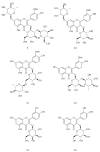In Vitro Anthelmintic Activity of Sea Buckthorn (Hippophae rhamnoides) Berry Juice against Gastrointestinal Nematodes of Small Ruminants
- PMID: 35741346
- PMCID: PMC9219796
- DOI: 10.3390/biology11060825
In Vitro Anthelmintic Activity of Sea Buckthorn (Hippophae rhamnoides) Berry Juice against Gastrointestinal Nematodes of Small Ruminants
Abstract
Gastrointestinal nematodes are one of the major threats in small ruminant breeding. Their control is difficult due to the development of anthelmintic resistance, and the search for new molecules endowed with anthelmintic activity (AH) is considered a priority. In this context, we evaluated the in vitro AH activity of two commercial sea buckthorn (Hippophae rhamnoides) berry juices, namely SBT and SBF. The in vitro evaluation was based on the egg-hatch test and larval exsheathment assay at different concentrations. Data were statistically analysed, and the EC50 was calculated. Chemical analyses were performed to evaluate the total polyphenol content of the juices and chemical profile of the most represented compounds. The role of the polyphenolic fraction in the anthelmintic activity of the juices was also assessed. At the highest concentrations, the activity of SBT was high in both tests and comparable to that observed in the thiabendazole-treated positive controls, while SBF showed a lower efficacy. Glycosylated isorhamnetin and quercetin were the most represented polyphenolic compounds in both juices. In conclusion, both H. rhamnoides berry juices tested in this study showed interesting anthelmintic properties in vitro.
Keywords: Hippophae rhamnoides; anthelmintic activity; gastrointestinal nematodes; isorhamnetin; polyphenolic compounds; quercetin; sheep.
Conflict of interest statement
The authors declare no conflict of interest.
Figures






References
-
- Charlier J., Rinaldi L., Musella V., Ploeger H.W., Chartier C., Vineer H.R., Hinney B., von Samson-Himmelstjerna G., Băcescu B., Mickiewicz M., et al. Initial assessment of the economic burden of major parasitic helminth infections to the ruminant livestock industry in Europe. Prev. Vet. Med. 2020;182:105103. doi: 10.1016/j.prevetmed.2020.105103. - DOI - PubMed
LinkOut - more resources
Full Text Sources

